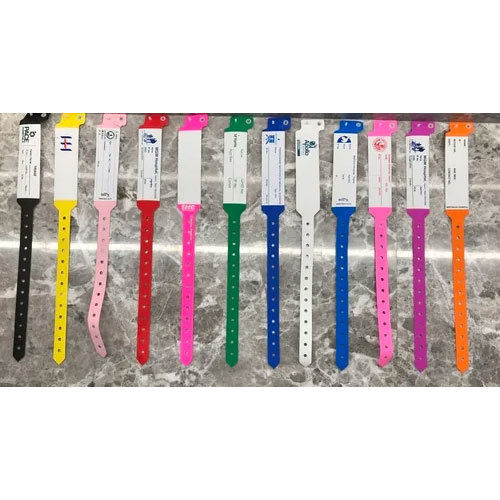Why Investing in a Premium Patient Identification Band is Crucial for Medical Institutions
Why Investing in a Premium Patient Identification Band is Crucial for Medical Institutions
Blog Article
Exploring the Numerous Types of Patient Identification Band Made Use Of in Medical Facilities
In the detailed world of health care, the important function of Patient Identification bands typically goes undetected. These bands, differing from basic paper wristbands to advanced RFID bands, develop the backbone of Patient safety and security protocols, ensuring precision in Patient Identification.
Understanding the Importance of Patient Identification Bands
While they might appear like plain accessories, Patient Identification bands play an important role in clinical facilities. These bands offer as a critical device for verifying Patient identification, stopping medical errors connected to misidentification. Patient Identification bands additionally aid in streamlining administrative jobs, making sure exact record-keeping and payment.
Traditional Paper Wristbands: Their Use and Limitations
Standard paper wristbands have been a staple in Patient Identification throughout different medical facilities. While their use prevails, they harbor specific restrictions that may influence their effectiveness in Patient monitoring. This section will certainly concentrate on the extent of their application and the fundamental disadvantages related to their usage.
Paper Wristbands: Use Scope
In the realm of Patient Identification, paper wristbands have long held a vital role. These bands are commonly used in outpatient settings, where the Patient's stay is short-term. Despite improvements in technology, the humble paper wristband stays a dependable and cost-efficient solution for Patient Identification in various healthcare circumstances.
Limitations of Paper Wristbands
Despite their extensive use, paper wristbands are not without their drawbacks. In enhancement, paper wristbands often do not have the technological abilities of more modern options, such as barcoding or RFID chips, restricting their capability to merely showing created info. Paper wristbands can trigger discomfort or skin inflammation to some clients, especially when used for prolonged durations.
Barcoded Wristbands: Innovations in Patient Identification
While Patient Identification has long been an essential element of medical care, the introduction of barcoded wristbands signifies a significant leap forward. These bands take advantage of the simpleness of barcoding innovation, allowing for Patient info to be rapidly checked and accessed. They enhance the rate and precision of Patient Identification, decreasing the danger of medical mistakes connected to misidentification. Barcoded wristbands are economical, simple to produce, and remove handwriting mistakes typical with manual systems. Nonetheless, they are not without constraints. While they supply improvements over standard bands, the barcode can end up being smudged or worn, rendering it unreadable. In spite of this, barcoded wristbands remain a necessary tool in contemporary healthcare settings, signifying the crossway of modern technology and Patient care.
Radio Frequency Identification (RFID) Bands: a Step In The Direction Of Futuristic Health Care
The development of Patient Identification bands has produced the appearance of Radio Recommended Reading Frequency Identification (RFID) Bands (patient identification band). These cutting-edge devices existing crucial advantages for medical care facilities, using a much more effective and technically advanced methods of Patient Identification. The implementation of RFID in healthcare is a significant step in the direction of a more futuristic method to Patient monitoring and safety
Comprehending RFID Bands

RFID Bands: Key Benefits
Mainly, these bands enhance Patient safety and security by providing exact, instant Identification, thus decreasing clinical errors. RFID bands can keep a large quantity of Patient information, consisting of medical history and allergic reactions, making it possible for personalized care. Overall, RFID bands stand for a substantial innovation in Patient Identification innovation, benefiting both clients and healthcare companies.
Implementing RFID in Medical Care
These bands give a smooth means to track and determine patients, ensuring their safety and boosting efficiency in treatment procedures. RFID bands decrease clinical errors by offering exact Patient Identification, which is vital in protecting against misdiagnosis or incorrect medication administration. Hence, the application of RFID bands is a considerable step towards improving click Patient safety and healthcare shipment.

Color-Coded Wristbands: Helping in Quick and Accurate Diagnosis
In the dynamic environment of a clinical center, color-coded wristbands have emerged as essential tools for swift and precise Identification of a client's medical condition. These wristbands, worn by people, lug specific colors that represent various medical conditions or conditions. As an example, red can show allergic reaction dangers, while yellow could represent a fall danger. This system is developed to offer prompt visual cues to medical care companies, improving Patient safety and security and care high quality. In emergency situations, using these helpful resources wristbands permits rapid decision-making. However, the efficiency of color-coded wristbands depends upon the harmony of shade interpretation across medical care organizations, requiring usual requirements for constant application.
Techniques for Effective Implementation and Management of Patient ID Bands
Achieving optimum use of Patient Identification bands demands a well-structured approach for their implementation and management. Patient education is likewise critical; patients should understand the objective of the bands and the need for their continuous wear. It's important to have a back-up strategy in location, such as barcode scanning or biometrics, to ensure that Patient Identification is never ever compromised.
Final thought
Patient Identification bands are important in clinical centers to guarantee safety and accuracy. Effective application and administration of these bands can dramatically lower clinical mistakes, improve efficiency, and enhance overall Patient treatment.
These bands, varying from basic paper wristbands to advanced RFID bands, develop the backbone of Patient security procedures, making sure accuracy in Patient Identification.The advancement of Patient Identification bands has actually brought about the appearance of Radio Regularity Identification (RFID) Bands. On the whole, RFID bands stand for a significant innovation in Patient Identification innovation, profiting both people and medical care companies.
RFID bands reduce clinical errors by supplying accurate Patient Identification, which is critical in stopping misdiagnosis or incorrect medication administration. Patient education and learning is likewise crucial; people have to comprehend the purpose of the bands and the demand for their continuous wear.
Report this page